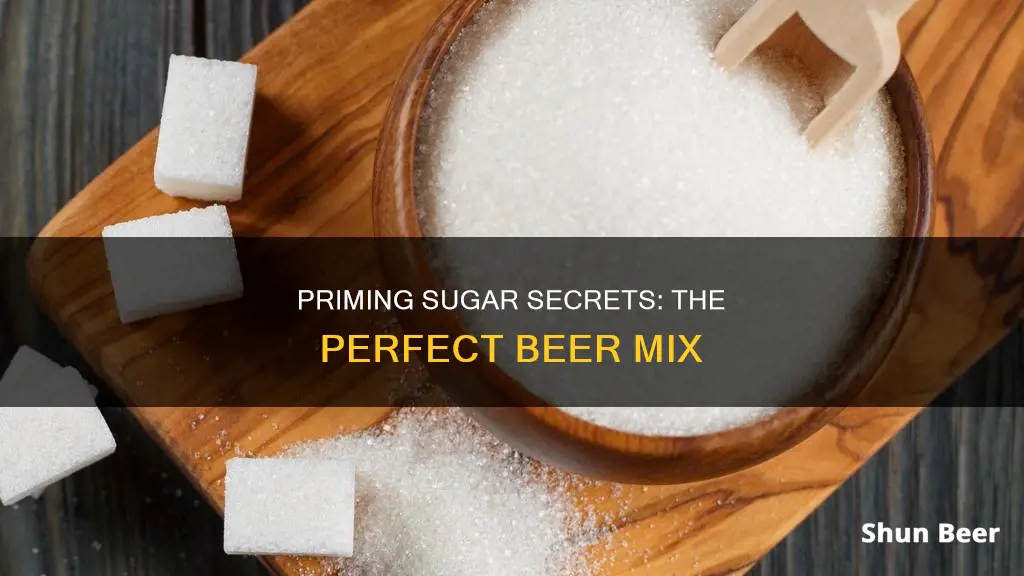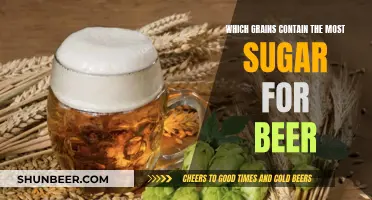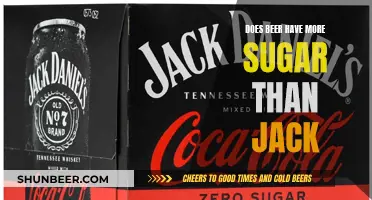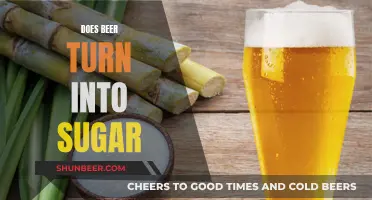
Mixing priming sugar into beer is a crucial step in the beer-making process, as it adds the desired level of carbonation and enhances the flavour and mouthfeel of the final product. This process, known as bottle priming, involves mixing dissolved sugar with beer and transferring it to bottles, creating carbonation as yeast consumes the sugar. The type and amount of sugar used, as well as the mixing technique, can impact the beer's carbonation level and overall quality. Corn sugar, table sugar, dry malt extract, and honey are commonly used for priming, each offering unique contributions to the beer's flavour and carbonation level.
| Characteristics | Values |
|---|---|
| Purpose of priming sugar | Add natural carbonation to beer |
| When to add priming sugar | After beer has fully fermented and been left to age for a week or two |
| Types of priming sugar | Corn sugar, cane sugar, dry malt extract, honey, or other sugars |
| Recommended priming sugar for beginners | Corn sugar |
| How to mix priming sugar | Boil and dissolve sugar in water, then add to bottling bucket with beer |
| How to avoid bottle bombs | Use correct amount of priming sugar, practice good sanitation, and ensure fermentation is complete |
| How long to carbonate beer | 2-3 weeks if stored between 65-70 degrees |
What You'll Learn

Preparing the bottles
Firstly, you will need a traditional, five-gallon batch, which requires 48 12-ounce bottles. It is important to clean and sanitise each bottle, preferably with a no-rinse brewing sanitizer like Star-San. If you are using old bottles, inspect them for mould. This step is crucial to ensure your beer does not spoil and to avoid oxidation and off-flavours.
Once your bottles are clean, you can prepare the bottle caps by sanitising them too. You may opt for Grolsch-style bottles with rubber seals, which can be sanitised in the same way as traditional bottle caps.
Now, it's time to prepare your priming sugar. It is essential to get the right amount of sugar for your brew, so it is recommended to use a priming sugar calculator. This will help you determine the precise amount of sugar needed based on the volume of your brew, the fermentation temperature, and the desired carbonation level.
Once you know the amount of sugar, boil about two cups of water and dissolve your sugar in it. Boiling ensures sanitation and helps dissolve more sugar. Make sure the sugar is completely dissolved, then set the mixture aside to cool.
You can now start the bottling process. Prepare your bottling bucket by ensuring the spigot is securely closed. Carefully pour the priming sugar mixture into the bottling bucket. Then, using a siphon or racking cane, slowly transfer your beer from the fermenter into the bottling bucket. It is important to avoid splashing and stirring, as this can introduce oxygen and cause off-flavours.
Let the mixture sit for 15 to 30 minutes to allow any sediment to settle. Then, using a bottling wand, carefully fill your bottles, leaving about 3/4 to 1 inch of headspace for carbonation. Be careful not to overfill the bottles, as this can lead to bottle bombs.
Finally, cap your bottles with a handheld capper and store them in a dry, room-temperature place. The yeast will remain active and feed on the priming sugar, creating carbonation in your beer. Allow the beer to condition for at least two weeks before testing.
Michelob Ultra Beer: Sugar-Free or Sweet Deception?
You may want to see also

Getting the bottle caps ready
Sanitize the Bottle Caps:
Before you begin bottling, it is crucial to sanitize all the equipment that will come into contact with your beer, including the bottle caps. Use a no-rinse brewing sanitizer to clean the caps thoroughly. This step helps prevent any unwanted bacteria or wild yeast from contaminating your beer.
Choose the Right Bottle Caps:
Select bottle caps that are suitable for your bottles. Standard-sized pry-off crown caps are commonly used for home brewing. You can also find caps with oxygen-absorbing liners, which help prevent oxidation and off-flavours in your beer. Make sure not to reuse pry-off caps and ensure they match your bottle type.
Prepare the Bottles:
Clean and sanitise the bottles you plan to use, preferably with a no-rinse brewing sanitizer. Inspect old bottles for any signs of mould and ensure they are thoroughly dried before proceeding.
Sanitize the Rubber Seals:
If you opt for Grolsch-style bottles with rubber seals, make sure to sanitise the seals just as you would with traditional bottle caps. This step ensures that your beer stays fresh and free from contamination.
Arrange the Bottles:
Once your bottles are clean and dry, arrange them on a baking sheet or a similar surface to keep them steady. This preparation will make the bottling process more efficient and help prevent spills.
Now that your bottle caps and bottles are ready, you can proceed to the bottling process, including mixing the priming sugar and filling the bottles. Remember always to follow sanitary practices to ensure the quality and safety of your homebrew.
Beer and Sugar: What's the Connection?
You may want to see also

Choosing and preparing the priming sugar
The priming sugar you choose depends on your personal preference and level of experience. Corn sugar (dextrose) is the most popular choice, as it is easy for yeast to consume and has a neutral flavour. It is also very soluble and easy to prepare—simply mix it with warm water and swirl. Table sugar (sucrose) is another cheap and easily available option, but it may produce inconsistent results and put stress on the yeast. Dry malt extract (DME) is another option, but it is less fermentable than corn or table sugar and can take longer to carbonate.
If you're feeling adventurous, you can also use "natural" unrefined sugars such as dark brown sugar or honey, which will add a subtle flavour and aroma to your beer. Honey, however, can be difficult to work with due to its varying density, composition, and viscosity. If you do use honey, it's recommended to use 1/2 to 1 cup of honey for every 5 gallons of beer.
Once you've chosen your priming sugar, you'll need to calculate the correct amount to add to your brew. This will depend on the volume of your brew, the temperature at which you fermented it, your target carbonation level, and the type of sugar you're using. You can use an online priming sugar calculator to determine the right amount.
When you're ready to add the priming sugar to your beer, combine it with 2 cups of water in a pan and bring it to a boil. Hold the boil for about 3 minutes, then cool the mixture. You can place the pan in the freezer or a mini-ice bath to speed up the cooling process.
Preparing the Bottling Bucket
Before adding the priming sugar to your beer, make sure your bottling bucket is clean and sanitised. If you're using a bottling bucket, ensure the plug is well-fastened. Then, add your priming solution to the bucket.
Mixing the Priming Sugar with the Beer
Slowly add your beer to the bottling bucket and mix it with the priming solution. Be careful not to stir up any sediment at the bottom of the bucket, as this can affect the taste of your beer. The process of siphoning the beer into the bottling bucket should be enough to mix the solution, but if needed, you can gently stir the mixture with a sanitised spoon.
Beers' Surprising Impact: Lowering Blood Sugar, How Many?
You may want to see also

Mixing the beer and priming sugar
Choosing the Right Priming Sugar
Priming sugar is any sugar that restarts the fermentation process and adds carbonation to the beer. The most common types of priming sugar are corn sugar (dextrose), table sugar (sucrose), and dry malt extract (DME). Corn sugar is the best option for beginners, as it is easy for the yeast to consume and has a neutral flavour. However, table sugar and dry malt extract are also viable options and can be used based on personal preference and desired flavour profile.
Calculating the Amount of Priming Sugar
The amount of priming sugar needed depends on the volume of beer being bottled, the desired level of carbonation (usually between 2.0-3.0 volumes), and the temperature of the beer. Online priming sugar calculators can be used to determine the exact amount of priming sugar required. These calculators take into account the type of sugar, volume of beer, and temperature to provide an accurate measurement.
Preparing the Priming Sugar Solution
To prepare the priming sugar solution, combine the calculated amount of priming sugar with two cups of water in a pan. Bring the mixture to a boil and hold it for about three minutes. After boiling, cool the sugar solution and cover the pan to prevent contamination. The solution should then be cooled to around 80 degrees Fahrenheit before adding it to the beer.
The priming sugar solution can be added directly to the bottling bucket or fermenting vessel. If using a bottling bucket, ensure that the plug is securely fastened. Gently rack or siphon the beer into the bottling bucket, being careful not to splash and minimise aeration. The swirling motion of the beer as it is transferred will help mix the priming solution. If using a fermenting vessel, the priming solution can be gently stirred with a sanitised spoon to ensure even distribution.
Bottling and Carbonation
Once the beer and priming sugar solution are mixed, carefully bottle the beer using a bottling wand or filter, leaving about ¾ to 1 inch of headspace for carbonation. Secure the bottles with airtight seals or caps and store them in a dry, room-temperature place. The beer will need to condition for about two weeks, allowing the yeast to consume the priming sugar and create carbonation. After this period, chill a bottle and test the carbonation. If needed, continue ageing the remaining bottles for a few more days until the desired carbonation level is achieved.
Sugar Secrets: Priming Beer with Precise Sugar Grams
You may want to see also

Bottling the beer
Step 1: Prepare the Bottles
You will need a traditional, five-gallon batch, which requires 48 12-ounce bottles. Clean and sanitise each bottle with a no-rinse brewing sanitizer like Star-San. If you're using old bottles, check them for mould.
Step 2: Prepare the Bottle Caps
Sanitise the caps, too. You can use Grolsch-style bottles with rubber seals, which can be sanitised in the same way as bottle caps.
Step 3: Prepare the Priming Sugar
Priming sugar is what restarts the fermentation process and brings the bubbles to your beer. Corn sugar (dextrose), table sugar (sucrose) and dry malt extract (DME) are the most commonly used sugars. Corn sugar is the best option for beginners as it is easy for the yeast to consume and has a neutral flavour.
The amount of priming sugar you need depends on the volume of beer you are making, the temperature at which you fermented it, and the target carbonation level. You can use an online calculator to work out the exact amount of priming sugar you need.
To prepare the priming sugar, boil two cups of water and dissolve your sugar in it. Boiling ensures sanitation and allows you to use less water as you can dissolve more sugar in hot water than in cold. Once the sugar is dissolved, cover the pan and set it aside to cool.
Step 4: Mix the Beer and Priming Sugar
Add the priming solution to your bottling bucket. Then, carefully siphon your beer from the carboy into the bottling bucket. It's important not to let the trub (the sediment at the bottom of your brew) mix with the beer, as it can ruin the flavour.
When combining the beer and priming sugar, avoid splashing, as this introduces oxygen to the brew, which can cause problems with the flavour. The swirling motion of the beer as it is put into the bottling bucket should be enough to mix the priming solution without causing aeration.
Step 5: Bottle the Beer
Using a bottling filter, carefully fill your beer bottles, leaving a 3/4 to 1-inch gap at the top of the bottle for aeration. Then, set the bottles aside for two weeks in a dry, room-temperature place. The yeast will remain active and consume the priming sugar solution, creating carbonation in your beer.
After two weeks, chill a bottle and test it. If it's not quite ready, leave the rest of the bottles for a few more days. If it's perfect, it's time to crack one open and enjoy the fruits of your labour!
Sugar Quantity for Brewing 40 Pints of Beer
You may want to see also
Frequently asked questions
Priming sugar is any fermentable sugar that is added to your beer to carbonate it and give it that fizz. It is the primary component in the priming solution.
Corn sugar (dextrose), table sugar (sucrose), and dry malt extract (DME) are the most popular priming sugars. Corn sugar is the best option for beginners as it is easy for the yeast to consume and has a neutral flavour.
The amount of priming sugar depends on the desired level of carbonation and the type of sugar used. A priming sugar calculator can help determine the exact amount required. As a general rule, for every five gallons of beer, use 3/4 cups (4 ounces, or 113 grams) of corn sugar, 2/3 cup (5.3 ounces, or 150 grams) of table sugar, or 1 1/4 cups (181 grams) of light dry malt extract.







